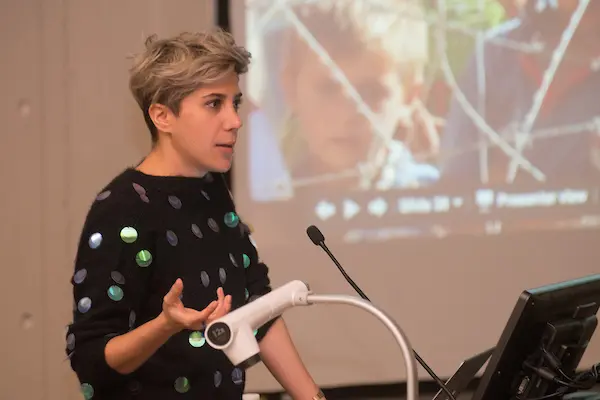Morehshin Allahyari Tells Students to Make Art Matter
 Image by Tory Germann
Image by Tory Germann
02/27/2017
By David Perry
For a while, Morehshin Allahyari didn’t know if her Feb. 22 artist’s talk at the university would happen. Although her work was already on display at the University Gallery in Mahoney Hall, the Iranian-born artist wasn’t certain if she’d be able to return to the United States from Germany, where she was when President Trump issued his travel ban.
Allahyari, 32, who is known for using new media to question the norms of society, politics and gender, was in Berlin to participate in Transmediale, the city’s annual festival of technology and art. After moving to the U.S. from Iran in 2007 to attend a master’s program at the University of Denver, Allahyari held a green card. But with Iran on the list of seven countries deemed a terror threat by the White House, she wasn’t sure she’d be allowed back into the U.S.
“We didn’t know what it meant for a while,” Allahyari said. “A lot of people told me I should get back to the U.S. immediately.” Thanks to a judicial ruling nullifying the president’s order, she was able to return home to New York — and eventually made it to her UMass Lowell appearance.
During her talk before a packed house of more than 100 students in O’Leary 222, Allahyari delivered a call to activism.
She is best known for using 3-D technology to re-create 12 of the ancient art pieces destroyed in a Mosul museum rampage by ISIS in 2015. Each piece of her work included a USB drive or memory card containing all of her research on the original artwork.
“I think of this as a time capsule,” she said.
A few of those pieces are among those in the University Gallery exhibit, which ran until Feb. 28. The exhibit also included work featuring forbidden Western icons Homer Simpson and Barbie, which were censored when she was growing up in Iran.
Allahyari, a leading advocate of technology-based art as activism, told the students to “interrupt” their own success if it wasn’t moving them forward. Her “3D Additivist Manifesto” calls artists to use “critical thinking in pushing the boundaries of the technology.”
She is in the midst of a one-year research residency at New York’s Eyebeam, a collaborative studio where artists work with technology. Her research concerns “digital colonialism,” exploring issues of ownership among the rich and powerful.
“A lot of 3-D scanners and printers are owned and used by companies from Silicon Valley,” she said. “They go to, let’s say, Africa or the Middle East and make 3-D scans of art and buildings and bring them back. Then they own those images and protect them. Colonialism is showing up in places it never has before.”
Students found her call to activism inspiring.
“It’s exciting to hear her speak and a great addition to seeing the gallery exhibit,” said Julien Saliba, a junior graphic design major. “Her call to activism makes me want to add my voice. It may be different than hers, but it’s clear there is room for all of our voices to fall into place.”
